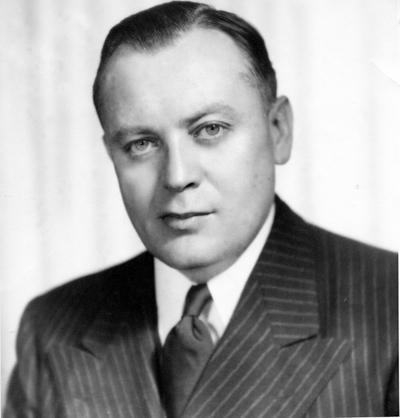Styles Bridges (Henry Styles Bridges)

Styles Bridges ran for governor of New Hampshire in 1934, and won, becoming the nation’s youngest governor at the time, according to John Gunther’s book, Inside U.S.A. He was elected to the United States Senate in 1936, and would serve until his death in 1961. In 1937 he retired from the Army Reserve Corps, in which he had served as a Lieutenant since 1925. In 1940 he attempted to win the Republican nomination for President; the nomination was eventually won by Wendell Willkie. That same year, Bridges also received two delegates for the Republican vice presidential nomination, which eventually went to Charles L. McNary. Bridges broke his hip on New Year’s Eve 1941 and missed several months of the next Senate session. Bridges was reelected to four subsequent terms in 1942, 1948, 1954, and 1960, but he did not complete his final term due to his death. He became the highest-ranking Republican senator, serving as chairman of the Joint Committee on Foreign Economic Cooperation when the Republicans had control of the Senate from 1947 until 1949, Senate Minority Leader from 1952 until 1953, President pro tempore of the United States Senate when the Republicans had control of it from 1953 until 1955, chairman of the Joint Committee on Inaugural Arrangements for both of the inaugurations of President Dwight Eisenhower, Chairman of the Committee on Appropriations when the Republicans had control of the Senate from 1947–1949 and 1953–1955, and Chairman of the Republican Policy Committee from 1954 until his death. In the Senate, John Gunther wrote, Styles Bridges was “an aggressive reactionary on most issues…and he is pertinaciously engaged in a continual running fight with the CIO, the Roosevelt family and the Union of Soviet Socialist Republics.”
Styles Bridges died of a heart attack on November 26, 1961, in East Concord and, after a service attended by a thousand people at the State House in Concord, was buried in Pine Grove Cemetery. He was one of the poorest men ever elected governor and still of modest means when elected to the Senate, yet his widow Doloris told Senator Lyndon Johnson that her husband had left her “a million dollars in cash”. Bridges willed his East Concord home to the state to serve as a residence for New Hampshire’s governors. The New Hampshire Governor’s Mansion is known as “Bridges House”. The “Styles Bridges Room” in the U.S. Capitol was named in his memory on March 12, 1981. Interstate 93 in New Hampshire, from Concord north to the Vermont state line, is named the Styles Bridges Highway. In December 2012, the Boston Globe called for the state to examine Bridges’ role in Senator Lester Hunt’s death and reconsider whether the state should continue to honor Bridges, or rename the highway.
Born
- September, 09, 1898
- USA
- Pembroke, Maine
Died
- November, 26, 1961
- USA
- Concord, New Hampshire
Cause of Death
- heart attack
Cemetery
- Pine Grove Cemetery
- East Concord, New Hampshire
- USA



